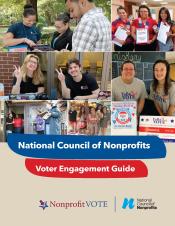Voting has started in several states. There’s no time to waste for charitable nonprofits to engage for two important reasons. First, nonprofits are nonpartisan in law, fact, and purpose. Unlike other tax-exempt entities, charitable nonprofits under 501(c)(3) are absolutely prohibited from engaging in partisan politics under federal law, a protection that allows us to focus solely on our missions of serving our communities.
Next, charitable nonprofits can and do play an important role in helping their communities get registered and vote. Nonpartisanship frees charitable nonprofits to have their communities' voices heard at the ballot box with no hidden agenda.
Let me explain.
Research proves that when nonprofits – on a nonpartisan basis – encourage voting, people vote at significantly higher levels than if nonprofits sat on the sidelines and did nothing. This is because nonprofits are trusted messengers with personal relationships in communities that have been traditionally underrepresented and overlooked. And because we must be nonpartisan, our message is not muddled with partisan overtones or impressions on candidates.
A nonprofit’s guide to nonpartisanship

full guide.
How can nonprofits safely and legally do voter engagement while remaining nonpartisan under the law? The Nonprofit Nonpartisan Voter Engagement Guide released this summer in partnership with Nonprofit VOTE breaks down the Rules of Nonpartisanship for all charitable nonprofits wanting to get engaged.
It begins by quoting the portion of the federal law that requires nonpartisanship:
A charitable nonprofit may “not participate in, or intervene in (including the publishing or distributing of statements), any political campaign on behalf of (or in opposition to) any candidate for public office.”
— Section 501(c)(3) of the Internal Revenue Code
Put plainly, a charitable nonprofit cannot use its tax-exempt status to support or oppose a candidate running for public office. This applies to candidates running for a position that is not associated with a partisan party (e.g. school boards, county councils, etc.). That’s it.
The Guide clearly breaks down the do's and don’t's of what this means in the real world.
A 501(c)(3) organization MAY NOT conduct partisan activities to support or oppose any candidate for public office, including:
- Endorsing a candidate or expressing support or opposition for any candidate or party (even for nonpartisan offices).
- Making a contribution to, or expenditure for, a candidate.
- Rating candidates on who is most favorable to your issue(s) or sharing messages or materials that rate or rank candidates.
- Letting candidates use the organization’s facilities or resources, unless those resources are made equally available to all candidates at their fair market value.
Nonpartisan activities 501(c)(3) nonprofits MAY do to encourage voter participation and promote voter education include:
- Promote or conduct nonpartisan voter registration in alignment with state law.
- Educate registered voters on a nonpartisan basis on the where, when, and how of voting.
- Encourage and remind people to vote.
- Distribute nonpartisan sample ballots, candidate questionnaires, or voter engagement guides.
- Host or co-sponsor a candidate forum in nonpartisan ways.
- Host or co-sponsor events so people learn about ballot measures (e.g., propositions, referenda, bonds) they will be asked to decide by voting and how the outcomes can affect their lives.
- Educate community members in nonpartisan ways on who the candidates are and what the offices do.
- Encourage staff to serve on Election Day as a poll worker, translator, or other nonpartisan volunteer.
- Continue issue advocacy during an election.
- Support or oppose ballot measures.
All nonprofit executives, staff, volunteers, and board members should note that nonpartisanship applies to the organization and not to individuals acting in their personal capacities. Everyone must take off “the hat” – so to speak – of representing the organization if they do want to endorse or oppose a candidate in an individual capacity, on your time using your own resources (like personal social media pages or during speaking engagements). You may also want to provide a disclaimer for anything in writing that the views expressed are your own and do not represent any organization.
Communicating and speaking with potential voters while remaining nonpartisan
Nonprofits are great resources and messengers for voter engagement because we are in the community day in and day out. Including voter registration information and asking whether community members have a voting plan can be a simple addition to the conversation. The Nonprofit Nonpartisan Voter Engagement Guide offers clear information on what can and cannot be said in case those conversations turn into someone asking for advice on who to vote for.
To be clear, nonprofits and staff cannot suggest which candidate to vote for or political party to support. Do not wear buttons, hats, t-shirts, or other accessories, for a candidate while working, volunteering, or doing voter registration drives sponsored or supported by your organization. If asked who to vote for, simply answer that you do not support or oppose any candidate and cannot offer advice. Suggest the person look up information on their candidates on resources like Vote411.org or BallotReady.org or talk to their family and friends. Answers to questions about specific candidates, differences between the parties, and ballot measures are also provided in the Guide. Plus, tips on how charitable nonprofits can use digital communications and social media are provided.
Refusing to support or oppose candidates for office builds respect and trust while preserving your organization’s integrity as nonpartisan. It reinforces that you are not a partisan hack and have no hidden agenda.
The message is clear: go vote.
Tiffany Gourley Carter is Policy Counsel at the National Council of Nonprofits.
This article is the first in a series on how to utilize the Nonprofit Nonpartisan Voter Engagement Guide between now and Election Day.
